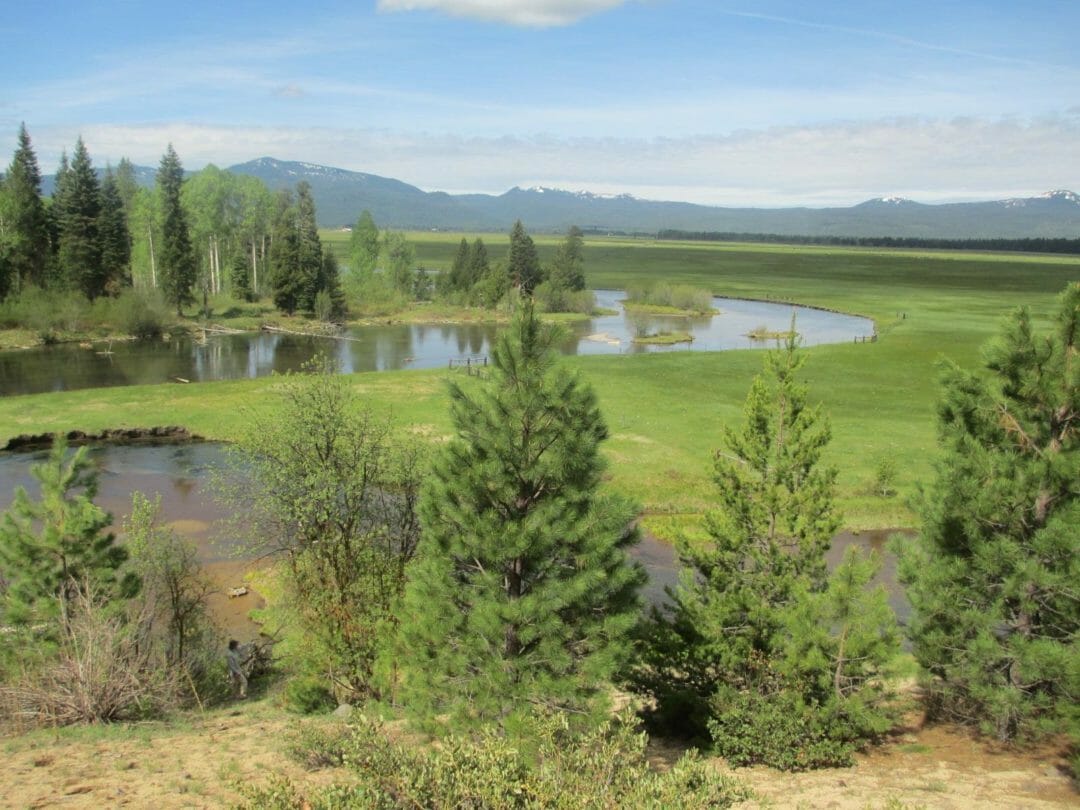Klamath Headwaters (Joshua Duplechian/Trout Unlimited)
Klamath River

Overview
The Klamath River drains an extensive watershed that stretches from the high desert of south-central Oregon to the cool, rainy redwood forests of the northern California coast. On the West Coast, only the Columbia and Sacramento Rivers produced more salmon historically. This complex watershed is home to native redband and bull trout in its headwaters, two species of endemic suckers (C’wamm and Koptu in the Klamath language), steelhead, Chinook and coho salmon, Pacific lamprey, and other native fish species. The Klamath’s sport fisheries are legendary among anglers, and its Chinook salmon runs are the cornerstone of the commercial salmon fishing industry in northern California. For over two decades, Trout Unlimited has been deeply committed to reconnecting the Klamath’s salmon, steelhead, and lamprey to historic habitat that has been blocked for more than a century. We are helping to remove four dams on the river, protecting and improving flows, and restoring spawning and rearing habitat for both anadromous and resident fish.
Dam Removal

Iron Gate Dam on the Klamath River. (Joshua Duplechian/Trout Unlimited)
Thanks to decades of tireless advocacy from indigenous Klamath peoples, Trout Unlimited, commercial fishermen and recreational anglers, and others, the largest dam removal project in history is now underway on the Klamath River. By the end of 2024, the four dams comprising the Lower Klamath River Hydroelectric Project will be gone, improving water quality and restoring access to over 420 miles of spawning and rearing habitat in the river’s upper basin for salmon, steelhead, and lamprey. For over twenty years, Trout Unlimited has worked closely with our tribal, fishing, conservation, and resource agency partners to reconnect the Klamath River and rebuild its legendary salmon and steelhead fisheries.
Restoration of the Reservoir Reach
To fully leverage the ecological benefits of dam removal, the National Oceanic and Atmospheric Administration (NOAA) Restoration Center partnered with Trout Unlimited and the Pacific States Marine Fisheries Commission (PSMFC) to produce a comprehensive report identifying and prioritizing the most impactful restoration projects within the “reservoir reach,” the span of the hydroelectric project on the Klamath. Two years of collaborative effort produced the Klamath River Reservoir Reach Restoration Plan. This report provides a key roadmap for state and federal agencies, conservation organizations, landowners, and regional tribes to develop and implement restoration projects that will boost depressed populations of native salmon, steelhead, and lamprey.
Restoration

Building beaver imitation structures in the Upper Klamath Basin (Joshua Duplechian/Trout Unlimited)
In the upper Klamath Basin, Trout Unlimited’s Oregon staff have been leading projects to restore habitat, fish passage, water quality, and instream flows in the Sprague, Williamson, and Wood River watersheds. In partnership with private landowners, Tribes, and federal and state agencies, projects include beaver-mimicry and instream wood placement in many headwater streams, removal of man-made barriers that block fish passage, and installing screens to protect fish from getting stuck in irrigation diversions. In the reservoir reach downstream (where the four Klamath River dams will be removed), extensive fencing projects are planned to help restore the former reservoir sites as native vegetation is re-established, and fish passage projects are planned for high-priority tributaries to maximize habitat availability after dam removal.
Monitoring

Monitoring water temperature in a tributary to the Klamath River (Joshua Duplechian/Trout Unlimited)
Effective restoration and resource sharing requires extensive, accurate data on instream conditions over time. Trout Unlimited staff have installed and are monitoring more than fifty temperature gauges, ten groundwater wells, and nine turbidity stations throughout the upper Klamath watershed and reservoir reach. They routinely monitor fish populations by electrofishing and document restoration, and instream flows with drone flights. All of this work is done in partnership with many state and federal agencies and supported by Trout Unlimited’s science team.
Chinook Smolt Study
To learn more about fish migration and habitat needs ahead of dam removal, Trout Unlimited has partnered with researchers at the UC Davis, the Oregon Department of Fish and Wildlife, the NOAA Restoration Center, the NMFS Southwest Fisheries Science Center, and the Klamath Tribes in a unique multi-year effort to release Spring Chinook smolts into the Klamath’s headwaters. These smolts are tagged and tracked as they move downstream towards the ocean. Their movements and survival offer critical lessons on how anadromous fish will behave and the habitat and water sources they require as they rebuild their populations.
Stewardship
As the dams come down and the river reopens for sea-run fishes, TU is also working to sustain fishing opportunities without compromising the recovery of salmon and steelhead in the Klamath basin. TU’s Oregon team provided input on updated angling regulations for the river from the California-Oregon border to Upper Klamath Lake, and Oregon in 2023 adopted regulations that protect out-migrating smolts and returning adult fish, while keeping the river open to recreational angling. On the California side, the state has offered several options for different segments of the river. TU partnered with other fishing groups to recommend allowing angling under current rules for anadromous waters and catch-and-release with no take of salmon for the next three to seven years. We will continue to advocate for science-based angling regulations that protect rebuilding salmon stocks while sustaining the Klamath’s unique fishing opportunities.













